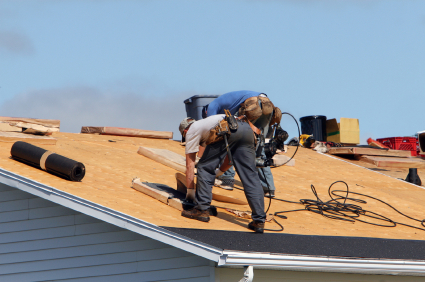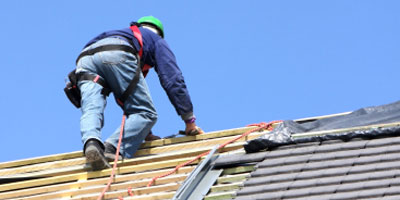How Weather Problems Can Impact Your Roofing Durability
Your roof covering encounters consistent difficulties from the weather, and it's important to understand just how these problems can reduce its lifespan. UV rays can weaken products, while hefty rainfall might bring about leakages. Snow and ice put included stress on the structure, and temperature level adjustments develop vulnerabilities. Each element plays a duty in your roof's sturdiness, yet how can you properly prepare for these hazards? The responses may surprise you.
The Results of UV Rays on Roofing Products
When your roof covering is subjected to sunlight, those unsafe rays can trigger significant damage over time. This destruction deteriorates your roofing system and makes it much less effective at securing your home.
You can alleviate these impacts by selecting UV-resistant roof covering products or using protective layers. Normal assessments also assist capture very early indicators of damages, enabling you to attend to issues before they intensify. Furthermore, think about mounting reflective roof alternatives that can disperse UV rays and keep your home cooler. By staying positive regarding UV exposure, you'll expand the life of your roofing system and enhance your home's general longevity. Taking these actions now can conserve you cash and stress later.
Exactly How Excessive Rain Can Cause Roof Damages
While UV rays can deteriorate your roof covering, too much rains positions one more significant hazard to its stability. When hefty rainfalls happen, water can merge on your roofing system, leading to potential leaks and structural damages over time. They can deteriorate faster than anticipated. if your roof products aren't designed to take care of long term direct exposure to moisture.
Blocked rain gutters can intensify these problems, creating water to overflow and seep right into your home. You might observe stains on your wall surfaces or ceilings, signaling that water is finding its means inside. Additionally, standing water can advertise mold and mildew growth, which not just harms your roofing however can likewise impact your indoor air quality.
To shield your roof, confirm your drainage systems are clear and functioning appropriately. Routine assessments can help you recognize weak points before they become pricey fixings, keeping your roof healthy also throughout hefty rains.
The Impact of Snow and Ice Accumulation
When snow and ice accumulate on your roof covering, you may not understand the stress and anxiety it places on the structure. That included weight can bring about major issues like roofing system drooping and even collapse. And also, ice dam development can trap water, causing leakages and further damages to your home.
Snow Load Stress
As winter season coverings your home in snow, the weight of collected ice and snow can place substantial anxiety on your roofing. You may not understand just how quickly snow can collect, especially during hefty tornados, so it's crucial to maintain an eye on the weight your roof is sustaining. Furthermore, recognizing your roof's structure and its snow load ranking can educate you concerning when to take activity.
Ice Dam Development
Ice dam development can come to be a substantial issue throughout winter months, particularly when snow gathers on your roof and temperature levels vary. When warmth escapes from your home, it thaws the snow on your roof, causing water to flow down. As this water reaches the chillier eaves, it ices up, developing a dam that prevents further drainage. With time, this trapped water can seep under tiles, causing leaks and substantial damage to your roof covering framework. To stop ice dams, ensure your attic room is appropriately insulated and aerated. You should likewise frequently eliminate snow buildup from your roofing. By taking these safety measures, you'll help expand your roof's life-span and stay clear of costly repairs caused by ice dam problems.
Temperature level Changes and Their Duty in Roofing System Wear And Tear
Temperature fluctuations can seriously impact your roof's lifespan. As materials expand and contract with cold and heat, they come to be a lot more vulnerable to cracks and damages. Furthermore, freeze-thaw cycles can intensify these problems, leading to additional degeneration with time.
Thermal Growth Impacts
When temperature levels rise and fall, your roof covering can undertake significant thermal expansion and tightening, which may lead to worldly tension and degeneration over time. As the sunlight heats your roof covering during the day, products broaden; when temperature levels drop at evening, they acquire. Routine inspections can likewise help you capture early signs of wear, ensuring your roof covering stays reliable and sturdy in safeguarding your home.
Freeze-Thaw Cycles
As winter embed in, the freeze-thaw cycles can damage your roofing. When temperature levels dip, moisture from rain or snow permeates into crevices and fractures. As it ices up, it increases, putting enormous stress on your roof covering products. This cycle repeats as temperatures fluctuate, slowly triggering wear and tear. You could notice roof shingles breaking, crinkling, or even disintegrating in time.
Overlooking these click here for more concerns can result in more significant troubles, including leakages and structural damage. To guard your roof, it's vital to check it regularly, specifically after severe climate. Dealing with minor concerns immediately can help expand the life of your roofing system, guaranteeing it endures the extreme impacts of freeze-thaw cycles throughout wintertime.
Moisture Levels and Their Effect on Roofing Integrity
While lots of people concentrate on temperature level fluctuations, humidity levels play a critical duty in establishing the honesty of your roof covering. High humidity can develop a moist environment that motivates mold and mildew, mildew, and algae development, every one of which can weaken roof covering products with time. If your roofing's air flow isn't sufficient, have a peek at this website wetness can obtain trapped, bring about timber rot and various other architectural problems.
On the other hand, reduced moisture can result in completely dry conditions, causing materials like roof shingles to come to be breakable and fracture. This brittleness can make them a lot more at risk to damage from various other weather elements.
To preserve your roofing's integrity, it is very important to keep track of moisture degrees and assure appropriate ventilation. Regular inspections and upkeep can aid identify potential concerns prior to they become substantial issues. Keeping your roofing in excellent condition means being proactive about moisture impacts, ultimately lengthening its lifespan and protecting your home.
Wind Damages: A Silent Threat to Your Roof
Humidity isn't the only weather variable to ponder; wind damages can calmly threaten your roofing's stability. Solid winds can raise tiles, loosen flashing, and also tear off whole areas of your roof. You might not see these problems right away, however gradually, they can lead to considerable leaks and architectural damages.
If you live in a location vulnerable to high winds, it is essential to watch on your roof after tornados. Check for any type of missing or damaged tiles and examine the sides where the roofing system satisfies other surface areas. Roofer Novi. Pay interest to any type of particles that might have built up, as this can catch dampness and get worse damage
Disregarding these indications could conserve you time now, yet it can cost you more in click here for more info the lengthy run. An aggressive approach to wind damages can assist assure your roofing system continues to be secure and strong, extending its life-span and protecting your home.
Preparing Your Roof for Extreme Weather Events
When preparing your roof for severe weather condition occasions, it's vital to examine its current condition and make necessary upgrades. Begin by inspecting for missing or damaged roof shingles, as these can lead to leaks during heavy rainfall or snow. Change any type of endangered products to guarantee a solid foundation.
Following, examine the blinking around vents, skylights, and smokeshafts. Effectively sealed flashing stops water from permeating in, which can trigger significant damage.
Think about strengthening your roof's framework, especially if your area is vulnerable to high winds or hefty snowfall. Setting up impact-resistant shingles can include an added layer of defense.
Lastly, clear gutters and downspouts to promote proper drain. Clogged seamless gutters can bring about ice dams or roofing leaks. By taking these aggressive steps, you'll help extend your roofing system's life expectancy and reduce prospective damage during extreme climate occasions.

Frequently Asked Concerns
Just how Typically Should I Check My Roofing for Climate Damage?

Can I Fix Roof Covering Damages Brought On By Weather Condition Myself?
Yes, you can fix roofing damage caused by weather on your own if you have the right tools and skills. Simply make sure you focus on security, analyze the damages completely, and adhere to appropriate fixing methods to prevent future problems.
What Roof Covering Materials Are Best for Extreme Climate?
For extreme weather condition, take into consideration metal, slate, or impact-resistant tiles. These materials hold up against hefty winds, hail, and snow much better than others. You'll assure your roofing lasts much longer, shielding your home from extreme aspects efficiently.
Exactly How Does Environment Modification Affect Roof Covering Longevity?
Climate change speeds up use on your roofing, triggering products to weaken quicker. Boosted temperature levels and severe tornados can lead to even more constant repair services. You'll require to consider resilient options to ensure your roof covering lasts much longer.
Should I Think About a Roofing Service Warranty for Weather-Related Issues?
Yes, you should most definitely consider a roof covering warranty for weather-related concerns. It protects you versus unforeseen damage, ensuring your financial investment remains secure. And also, it gives assurance during uncertain weather.
How Extreme Rain Can Lead to Roofing Damages
When hefty rains happen, water can merge on your roof, leading to possible leakages and architectural damages over time.Humidity isn't the only weather condition factor to ponder; wind damages can quietly threaten your roof covering's honesty. By taking these proactive actions, you'll assist expand your roofing's life-span and decrease prospective damages during severe weather condition events.
Can I Repair Roof Covering Damage Created by Climate Myself?